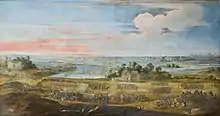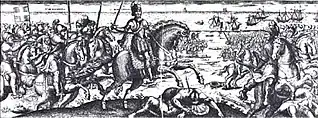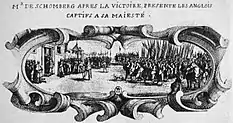Battle of Pont du Feneau
The Battle of Pont du Feneau was the last battle of the siege of Saint-Martin-de-Ré by the English forces that had come to help the Huguenot rebellions of La Rochelle. It took place on 8 November 1627. The English lost the battle, and this final failure forced them to withdraw back to England.
| Battle of the Pont du Feneau | |||||||
|---|---|---|---|---|---|---|---|
| Part of Huguenot rebellions and the Anglo-French War (1627–1629) | |||||||
 Painting by Laurent de La Hyre depicting the battle | |||||||
| |||||||
| Combatants | |||||||
|
|
| ||||||
| Commanders and leaders | |||||||
|
Jean Caylar d'Anduze de Saint-Bonnet Henri de Schomberg Louis de Marillac Pierre de Gondil (WIA) |
George Villiers Mountjoy Blount (POW) Milord Grey (POW) | ||||||
| Strength | |||||||
| About 4.500 soldiers and 200 cavaliers | About 3.500 soldiers, 68 cavaliers, and 4 cannons | ||||||
| Casualties and losses | |||||||
| About 550 | About 1800 soldiers, 68 cavaliers, and 4 canons | ||||||
Before the battle
English side
The English forces, having been defeated earlier that day at the siege of Saint-Martin, pulled back to the village of Loix, where their ships were anchored. Because of bad food, many soldiers in their army were sick.[1] The army was commanded by George Villiers, the first duke of Buckingham, and was composed of 12 infantry regiments and 4 cannons, as well as several volunteer rochelais protestants,[2] all covered by the cavalry, consisting of about 68[3] horses.[4]
Not having seen the French forces since their retreat from Saint-Martin, Buckingham's troops thought the French would not attack and, growing reckless, were neither walking in closed or open ranks. They arrived at the wooden bridge of the Feneau that they had built when they first landed on the island, that linked the island of Loix to the rest of l'île de ré.
French side
The French troops were commanded by the Maréchal Henri de Schomberg who, informed of the English retreat by Jean Caylar d'Anduze de Saint-Bonnet,[5] had reassembled his army and begun pursuing the English. The French cavalry was commanded by Louis de Marillac.[6]
The battle
The English vanguard marched towards Loix. Two English battalions, commanded by colonels[7] Sir Edward Conway, Sir Peregrine Barty, Sir Henery Spry, had crossed the bridge. Another battalion, led by Colonel[7] Sir Charles Rich, the brother of the count of Holland Henry Rich, 1st Earl of Holland[8] and half brother of Mountjoy Blount, 1st Earl of Newport, Sir Alexander Brett and the lieutenant of Sir Thomas Morton (he being sick), were getting ready to cross the bridge[2] with the four cannons.[3] The two last battalions, that had not yet engaged themselves on the bridge, were commanded by Colonel[7] Sir William Courtney, Lieutenant-Colonel[7] Sir Edward Hawley and Sir Ralph Bingley.[2]
The Maréchal de Schomberg, having crossed the village of La Couarde, was informed by Marillac of the English position.[2] The English vanguard started to engage itself, slowly, because of the narrowness, on the bridge of Feneau.[6] Judging the time to be right, the Maréchal ordered the cavalry captain Bussi-Lamet to charge the English rearguard with his squadron. He was followed closely by Marillac and Schomberg himself, leading the rest of the cavalry.[5] The English cavaliers retaliated but were defeated. Many English were killed, including Sir William Cunningham, and others were captured, including Mountjoy Blount, 1st Earl of Newport, colonel of the English cavalry, and half-brother of Sir Charles Rich and the count Holland,[9] Henry Rich, 1st Earl of Holland.[2] The English infantry intervened but also was defeated. Two regiments of the French infantry, the Piémont regiment, commanded by François Duval de Fontenay-Mareuil,[10] and the Champagne regiment commanded by Pierre Arnaud[11] arrived in the melee.[12] An important part of the English forces was violently pushed in the many muddy ditches in the area.[5] The two English battalions before the bridge were defeated. A few rochelais protestants managed to cross the bridge. The French then started crossing the bridge, killing everyone in their way, notably Sir Charles Rich and Sir Alexander Brett, that tried to defend it.[3] There are two different versions of the outcome of the battle.
English version
After having crossed the bridge, the French forces, guided by Marillac, confronted Sir Thomas Fryar and Lieutenant-Colonel Hackluit commanding 40 pikes and 20 musketeers guarding the artillery and munitions. They were rapidly assisted by Sir Piers Crosby, commanding an Irish regiment. The French then panicked and withdrew to the bridge, disobeying the orders of Marillac. They then rallied and the count of Saligny, with a group of pikemen, charged again. They were, however, repelled and lost a commander. They charged a final time, were repelled again and withdraw from battle and crossed the bridge back, chased by the English. While routing the French made Marillac fall from his horse. The English put an end to the chase and crossed the bridge back to the island of Loix. The guarding of the bridge was given to Sir Piers Crosby. A few days later, when the sailing conditions became better, Crosby burned the bridge, and the surviving English forces embarked on their ships.[3][2]
French version

Marillac dismounted from his horse and took over the command of the forces.[13] After having crossed the bridge, the French forces captured the four small cannons of the English artillery.[5] Few French soldiers fought on the front line, as a large part of the French forces took time capturing prisoners and the English arsenal. Marillac gave the order to move the arsenal a hundred feet back. The count of Saligny then arrived with a few fresh men. He fought remarkably, and the English soldiers lifted up their pikes and marched towards him. He only had a dozen men left, including Feuquiere and Porcheux, captain of the guards regiment,[14] that stood their ground and held the line. The men around Marillac pulled back in disorder, in spite of his orders, and even made him fall down. Saligny and his men, however, held on and contained the English, allowing the French soldiers to get refreshed and return to the melee. The fight lasted for two hours, after which the French triumphed over the English.[13]
The English army was in a mass rout. The causeway to Loix was covered in bodies, the ditches were full of men that were knocked unconscious in the mud. Some English soldiers swore they were Catholic, even showing rosaries and asking for mercy, but the French were ruthless. Many French noblemen were in the melee: the marquis of Annonay, Charles de Lévis-Ventadour,[15] who would later become duke of Ventadour; Antoine d'Aumont de Rochebaron, marquis of Villequier; the knight of Chappe and his brother; Jean of Estampes-Valençay, baron of Valençay; the count of Charraux or Chârost Louis of Béthune, who would later become captain of the King's bodyguards; the count of Saligny, "a man of heart and of unique virtue"; Isaac of Raynié, Lord of Drouet; L'isle-Cerillac ; Manassès de Pas de Feuquières; L'isle Montmartin ; Pierre Arnaud, mestre de camp of the regiment of Champagne; Alexandre of Garnier, Lord of the Garets; de Jonquieres; Jean-Louis the 1st of Louët of Calvisson; and Jacques of Castelnau of La Mauvissière. Toiras himself fought, sword in hand. The English soldiers fled on every side, in the marshes, on the ditches' crossings, in the vineyards, constantly under fire from the French troops that chased them.[6] Schonberg ordered the French troops pursuing the English to Loix to stop because they needed to rally and reorganize. Furthermore, night was falling. The retreat was signaled. The maréchal had the bridge guarded until he was certain that the English army had withdrawn from the island's soil.[12]
Outcome of the battle
The air was fire and smoke, the land was covered in cadavers, and the water was reddened by the blood.[12]
The outcome of the battle was very costly for the English, counting about 1.800 dead;[12] including 5 colonels; 3 lieutenant-colonels; 20 gentlemen, including Sir Henry Spry, Sir Charles Rich, Sir Alexander Brett, Sir Ralph Bingley, Sir William Cunningham, and 150 officers;[13] and a thousand injured.[6] 46 flags were captured. The captured included Milord Montjoye, cavalry commandant; the colonel[14] Milord Grey (possibly Henry Grey, 1st Earl of Stamford), grand master of the artillery; 35 captains or officers; 12 gentlemen; and between 100 and 120 soldiers. Every English horse, including Buckingham's, was captured, as well as the 4 cannons.[13]
Colonel Grey fell in a salt-pit during the battle, and shouted out to save his life, "A hundred thousand crowns for my ransom!". He was therefore captured and not killed.[16]
The Maréchal de Schonberg did not say a word about the French casualties,[6] however, they were probably close to 500 or 600.[2] The injured included the Général des Galères, Pierre de Gondi, having received two pistol shots to the shoulder; the Marquis of Villequier having received a musket shot through his body (but "the injury was without danger"[14]); De Iade, the captain of Schonberg's bodyguards and his squire took a pistol shot to the knee; Cussigny (André, lord of Cussigny and the barres ?), injured by a pike stab to the throat,[13] and Porcheux having had his thigh torn.[12] Toiras himself nearly got injured, taking two pistol shots that holed his hat.[13]
Aftermath
Of the 46 flags, the first having been captured by Sieur de Belinghem helped by Sieur de Moüy de la Mailleraye,[12] all were sent to Paris by Claude de Saint-Simon and displayed on the vaults of Notre-Dame.[1]

Toiras went back to the citadel of Saint-Martin, where the prisoners were also taken, to keep track of the Anglo-Rochelaise fleet. Some of the prisoners were ransomed. Schomberg returned to Saint-Martin as well to rest. He preferred not to leave the island until he was sure of the final departure of Buckingham.[6]
On the English side, about 2.000 survivors were on the ships including Benjamin de Rohan, lord of Soubise and younger brother of Henri II de Rohan, a French protestant. Buckingham, after having let his troops rest, left on 17 November to return to England after 3 months and 6 days of battle, promising to the rochelais protestants who had re-supplied his troops with fresh water twice to return with a bigger army. He would however not be able to stay true to his word, being assassinated by John Felton at the Greyhound Pub in Portsmouth on 23 August 1628, before the departure of the second expedition.[6]
Two centuries later, salt producers near the bridge of Feneau opened a pit to bury the many bones, bullets, and cannonballs scattered around on the ground.[6]
Posterity
The battle was painted by Laurent de la Hyre in "La défaite des Anglais en l'île de Ré par l'armée française le 8 novembre 1627", (the defeat of the English on île de Ré by the French army on the 8th of November 1627) between December 1627 and early 1628. The painting is large, at 112x120 cm.[17] It is conserved in Paris, musée de l'Armée, hôtel des Invalides.[18]
See also
Notes and references
- Dumas, Alexandre (1849). Les Trois Mousquetaires. Paris: J.-B. Fellens et L.-P. Dufour. pp. 342–347.
- Edward, Herbert (1860). The expedition to the Isle of Rhe. London: Whittingham. p. 227.
- William, Sanderson (1658). A compleat history of the life and raigne of King Charles. London. p. 98.
- "" La Défaite des Anglais en l'Île de Ré par l'armée française le 8 novembre 1627 " de L. de La Hyre | Le blog des collections". collections.musee-armee.fr (in French). 17 April 2014. Retrieved 25 August 2017.
- Massiou, M.D. (1836). Histoire politique, civile et religieuse de la Saintonge et de l'Aunis: depuis les premiers temps historiques jusqu'à nos jours. Saintes. p. 376.
- Eugène, Kemmerer (1868). Histoire de l'île de Ré depuis les premiers temps historiques jusqu'à nos jours. La Rochelle: impr. G. Mareschal.
- John, Entick (1757). A New naval history, or, compleat view of the British marine, in which the Royal Navy and the Merchant's Service are traced through all their periods and different branches. London. p. 427.
- "Charles Rich". geni_family_tree. Retrieved 25 August 2017.
- "Henry Rich, 1st Earl of Holland". geni_family_tree. Retrieved 25 August 2017.
- Pinard, M. (1763). La Promotion des Lieutenans généraux des armées du Roi, du 25. Juillet 1762. & les Maréchaux de camp depuis la création de cette Charge jusqu'en 1715. Paris: Claude Herissant. p. 108.
- de Courcelles, Jean Baptiste Pierre Jullien (1820). Dictionnaire historique et biographique des généraux français, depuis le onzième siècle jusqu'en 1820. Paris. p. 154.
- Baudier, Michel (1644). Histoire du Mareschal de Toiras, où se voient les effets de la valeur et de la fidélité, avec ceux de l'envie et de la jalousie de la cour, ennemies de la vertu des grands Hommes. Paris: Sébastien Cramoisy. p. 98.
- Le Mercure françois ou la Suitte de l'histoire de la paix commençant l'an 1605 pour suite du Septénaire du D. Cayer, et finissant au sacre du très grand Roy de France et de Navarre Louis XIII. Paris. 1627. pp. Book 14, page 199.
- Baron de Chabans (1634). Histoire de la guerre des Huguenots faicte en France, sous le regne du Roy Louys XIII. Paris: Toussaint du Bray. p. 501.
- Beucher, Joël. "Charles de Lévis-Ventadourhttp://www.histoireeurope.fr/RechercheLocution.php?Locutions=Charles de Lévis-Ventadour - Histoire de l'Europe". www.histoireeurope.fr. Retrieved 26 August 2017.
- Howell, James (1673). Epistolæ Ho-Elianæ. Familiar Letters Domestic and Forren - Fourth edition. London: Thomas Guy. p. 185.
- http://www.notre-ile-de-re.com/wp-content/uploads/Laurent-de-La-Hyre.jpg
- "La défaite des Anglais au Feneau". Chroniques ordinaires des petits moments de la vie rétaise (in French). 23 September 2014. Retrieved 27 August 2017.